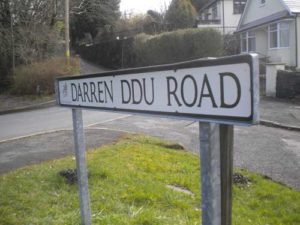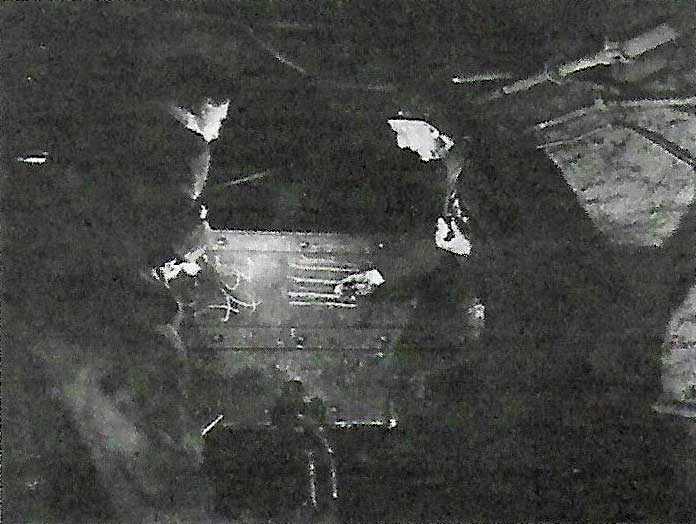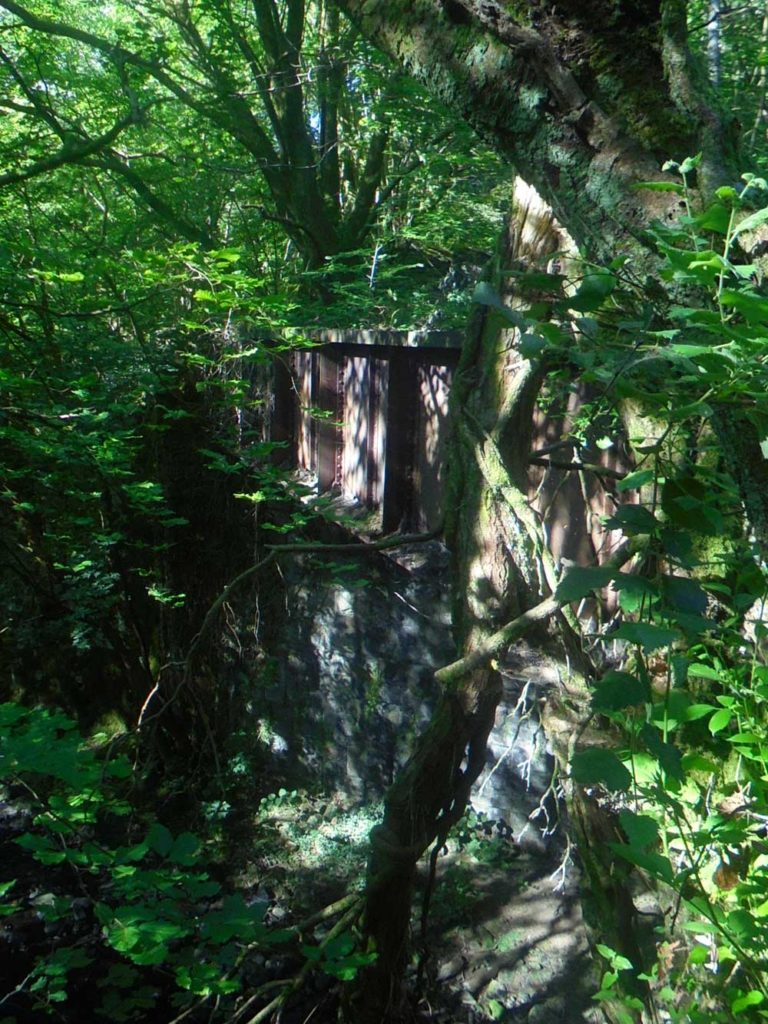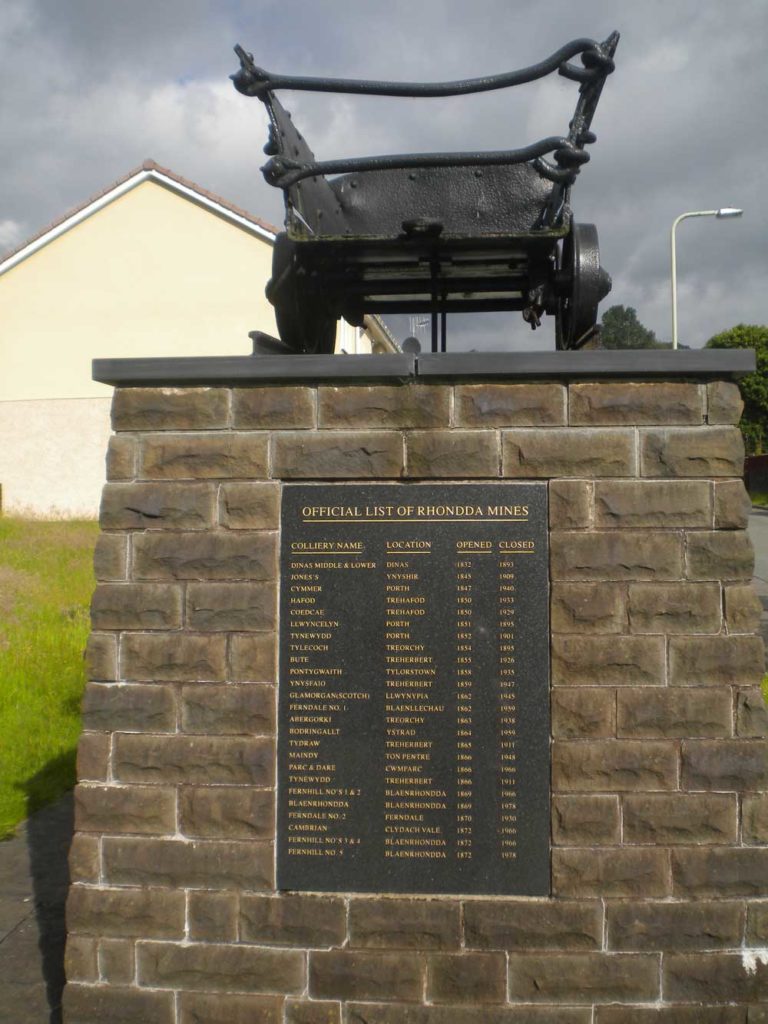Not surprisingly, from the mid nineteenth century until after the end of WWII, coalmining features prominently in the story of the Moses family – on both sides of the Atlantic. The following chapter gives an insight into the working conditions some family members experienced in one particular part of the South Wales coalfield.

One of the most interesting aspects of researching your family history is that you get to unearth the facts behind certain assumptions you once held. When your ancestors were coalminers living in Ynysybwl, it would be reasonable to assume that they had all worked at The Lady Windsor Colliery, the very reason for “The Bwl’s” existence. But although my grandfather ended his working life as a training officer at said colliery, it seems that most of the coal mining done by my family occurred a mile to the south, at the very edge of the village. Here, at the bottom of New Road, once stood the Darren-Ddu Level which opened in 1842; so predating it’s much larger neighbour by some 42 years! Three generations of the Moses family once worked here, and my nan’s brother, John Evans ME, actually managed and owned it for a time. Twm Moses seems to have been the first family member to swap the farm for the Darren-Ddu coalface, circa 1888, but when John Evans took it over as manager in 1914, it became the mandatory place of employment for the Moses and Evans families; the sort of behaviour which gives nepotism such a bad name!
To illustrate how practical people had to be back then (pre-motorcar), at various times between 1888-1918, there were three different generations of the Moses family living in No’s 68, 70 & 72, at the bottom end of New Road; literally a five minute “commute” to their place of work. My Grandfather, Gwilym Thomas Moses, was John Evans’ brother-in-law, and he became under-manager at the Level. John Evans bought Darren Ddu in 1927 at an auction, after the previous owner, Thomas Taylor, had died in 1925. Darren-Ddu certainly had it’s ups and downs, with the number of men employed varying between 5 and 126; indeed at times the mine had laid idle. There is a famous old photograph showing men and boys desperately scavenging for lumps of coal on the tips of Darren-Ddu during the national coal strike of 1912. The Level struggled on through the poverty of the 1930’s before John Evans officially closed it around 1940. The last straw was having all his stock captured by the Germans aboard a “coaler” at Dunkirk early on during WWII. It seems likely however that the Level was mined on and off unofficially during the War. Apparently John Evans had previously tried to stave off the inevitable when, in 1936, he asked his brother (Ivor Roderick) about the possibility of re-mortgaging the Evans family home (Maes-y-Dderwen Ynysybwl).
After the demise of Darren-Ddu, Gwilym T. Moses went to work belatedly at The Lady Windsor, whilst John Evans headed over to Hopkinstown to become the Ventilation and Training Officer at The Great Western Colliery. By all accounts a popular and nice man, he eventually retired in his 70’s (mid to late 1950’s). He lived at Penrhos Cottage, Ynysybwl, Nant-y-Mynydd, Graigwen Road, Pontypridd, and finally New Road, Ynysybwl. His children were Ieuan & Muriel Evans.

“Following forty-five years in the pit Gwelyn (sic) Moses was appointed training-officer. He is in charge of all the young lads upon who, the future of the mine depends, and whom it is becoming more than ever important to attract to the job. He is drawing a diagram of the mine’s coals seams”
From The GEOGRAPHICAL MAGAZINE of November 1951
The flooding of the Darren-Ddu Colliery
The following interesting account of a gallant and effective attempt at rescuing, when the Darrenddu Colliery was flooded in 1897, is extracted from one of the South Wales newspapers:-
“The Darrenddu Level is situated on the main road at the lower end of the Ynysybwl village, and about nine o’clock on a Sunday morning passers-by were alarmed by perceiving a huge volume of water issuing from the level and on to the highway. It was ascertained that Mr. Enoch Jones the manager, and Gwilym Moses, one of the workmen, were inside, and as the large crowd which gathered in the vicinity during the next three or four hours received no intimation of the fate of the two men, there was a growing suspense which became very painful. Several gallant attempts were made to rescue them, and these as well as the terrible position of the two imprisoned men, in utter darkness for a space of five hours, will provide a thrilling chapter in the history of colliery accidents.
The level is driven into the hillside and extends for the distance of about eight hundred yards to the barrier dividing it from the old workings, which were worked by means of a level on the Pontypridd side. For some years house coal has been worked there, but owing to an inrush of water about twelve months ago there has been no output of coal for some time. The level has been driven in a straight line for about three hundred yards, and in consequence of a fault in the strata there was a “dip” and a “rise” for another three hundred yards. The barrier was about two hundred yards distant, and was reached by means of a rise. Twelve months ago there was a rush of water to the dip or swamp, and for about two months pumping operations were carried on, but as this was found to be rather expensive the company decided to drive a hard heading in a straight line from the entrance to the dip to the top of the rise. This was done, and on Sunday morning the manager and the workman, Gwilym Moses, went into the level to continue the preparations for tapping the barrier. This work was commenced the middle of last week. Water was found to be rushing out from one hole, and as some was seen trickling from a fissure in the barrier an iron bar was inserted, and almost instantaneously a large piece of coal was displaced and the water rushed out in a volume. The two men sprang to a place of safety, but Moses was caught by the torrent, and as he was being swept down the declivity by the current and past the manager the latter gripped him by his hand and swung him round to the side. Had this not been done he would have been carried away, and in all probability have been quickly drowned. Owing to the rush of foul air their lamps suddenly went out, and they were plunged in darkness. A portion of the mine on each side where the coal had been worked was higher than the road, which had been lowered in order to give sufficient height for the horses. Had this not been the case both men would have been swept away by the torrent, but even as it was, their position was a most perilous one. For a short time they remained together on the side, but owing to the very small space between the road and the side, and the rushing water beneath them, it was agreed that Moses should make an effort to reach the other side where more space was available. It was difficult to do so, but they succeeded in the effort. They joined hands, and whilst Mr. Jones held tightly to the side with one hand, Moses managed with some difficulty to reach the other side. The manager then told him to go down as far as he could, and Moses crawled on his hands and knees for about twenty yards, beyond which he could not go owing to a barrier. Moses then lay down on the ledge with the water passing a few inches beneath him, but the manager was not so fortunate. He had no room to stand or to lie down, and his sitting room was very limited. He was in a stooping posture, whilst his feet were actually underwater, which splashed over him. He was unable to cross to the other side, being afraid to make the attempt lest he should lose his foothold and be swept away by the black current.
Notwithstanding the roar of the rushing water the two men were able to hear each other’s voices by shouting, and they cheered each other as best they could under the circumstances. What they feared most was the foul air, which already began to affect them. They, however, kept moving slightly from one spot to another, and shouting repeatedly in order to thus help each other to keep awake. They felt, as they afterwards stated, that if they were once overpowered their chances of escape would be small indeed. Owing to the cold air they became gradually benumbed, and the manager’s position, with his feet and legs in the rushing water, was, it can readily be conceived, a terrible one. Their anxiety increased as the hours wore on, and no sign of escape presented itself.
Between eleven and twelve o’clock, however, they were greatly cheered upon seeing a glimmer of light approaching them in the distance, and they shouted as loud as they were able. “Here they come,” joyfully exclaimed the manager, but almost as he uttered the words the light went out, and then hopes of rescue for the moment were dashed to the ground. Some time afterwards Moses saw another light and heard a faint sound, and he shouted again until he became hoarse. The rescuers heard him and replied, and Moses sent the glad news to the manager, who, higher up the rise, was unable to hear the voices. About one o’clock the rescuers reached Moses, and in reply to the anxious enquiries about the manager, he replied that he was about twenty yards higher up. Moses wanted to go with them to the manager’s assistance, but owing to his weak condition was not allowed to do so, and was assisted out, whilst the others fought against the rushing torrent until they reached Mr. Jones, who was in a very exhausted state, and stiffened with the cold. He was taken out of the mine with some difficulty, and assisted to the engine-house. Both the manager and the miner were soon afterwards, however, able to walk home, little the worse for their trying experience, and much to the joy of their family and friends. Their presence at the mouth of the level was hailed with a feeling of intense relief by the large crowd, who were unstinted in their praise of the gallant efforts made by the rescuers. The first attempt at rescue was made about ten o’clock by Albert Weaver and Tom Moses (a brother-in-law [should be uncle] of the imprisoned Moses), who entered the level carrying naked lights. They waded through the water for a few hundred yards, but they were obliged to return, the pressure of water making it impossible for them to proceed, their lights being also extinguished by the foul air. Another attempt, however, was made, the two men named being accompanied by seven others, including F. Beechey, Arthur Hollister, G. Lewis, and D. Davies. They were provided with safety lamps from the Lady Windsor Colliery of the Ocean Company, but having reached the junction with the dip, and gone some distance up the rise where the men were imprisoned, they were obliged to return owing to the strong current. Having put fresh oil in their lamps and trimmed them, they made a second attempt. This time they failed to go as far, and their lights went out owing to the air. They were enveloped in Egyptian darkness, but they determined to push on in spite of such adverse circumstances. Mr. Beechey (who had formerly worked in the level, but who was then a certificated manager elsewhere) being accustomed to the road, led the way, followed by the others. Beechey shouted and heard a faint response, and cheered by this the party forged their way onwards, and at last reached Moses, and a few minutes later the manager. They were at the time in utter darkness, and had to wade through water a couple of feet deep, whilst sometimes it reached even to their waists.”
Interesting that the writer, throughout the account, refers to the manager as Mr. Jones, whilst humble coalminer Gwilym is referred to simply by his surname. Also interesting is the use of the phrase “Egyptian darkness” when somebody with the name Moses was involved; I wonder did the writer choose it deliberately.

Pontygwaith/Bridge to work – this bridge across the River Clydach once led to the Darren Ddu Level
Apart from an old “works” bridge across the River Clydach, there is now nothing left at all to indicate where the Darren-Ddu Level once stood, but not surprisingly there is an impressive memorial to commemorate The Lady Windsor Colliery. Dedicated on 8th August 1993, it reads –
Ynysybwl & Coed-y-Cwm Community Council, Cllr. Maldwyn Kinsey 1993-94. “To the memory of all who worked Lady Windsor Colliery many of whom died through accident or industrial disease and to commemorate it’s closure on 26/3/1988”
“Cofiwn am bawb bu farw yn ystod y can mlynedd bu’r pwll ar agor” Surprisingly this is not the Welsh translation for the English text above; instead it reads – “We remember all who died during the hundred years the pit was open”
My Grandfather Gwilym Thomas Moses was one of those who died prematurely whilst working at this pit.
Four miles west of Ynysybwl is another memorial with connections to the Moses family. It was erected at Dinas (in 2013) on the site of the very first coal mine sunk in The Rhondda Valley’s (in 1812), and it lists all the collieries which once dominated the local landscape. My Gt. Grandfather Gwilym Moses briefly worked at one of these before returning to Ynysybwl, and his uncle’s Charles Moses, Moses Moses and (before he emigrated) Evan IV Moses would have spent their working lives down some of these pits. Indeed Charles I Moses, at the end of his life, ended up living just a stones throw from this memorial at 22 Cymer Road.

